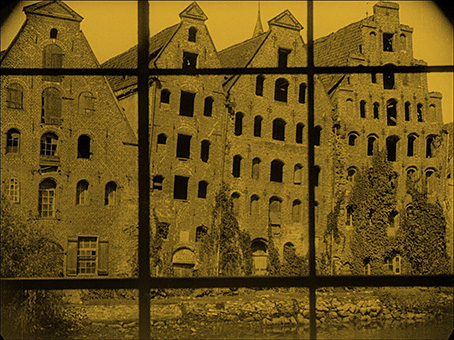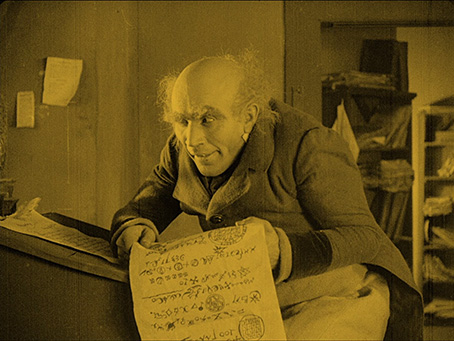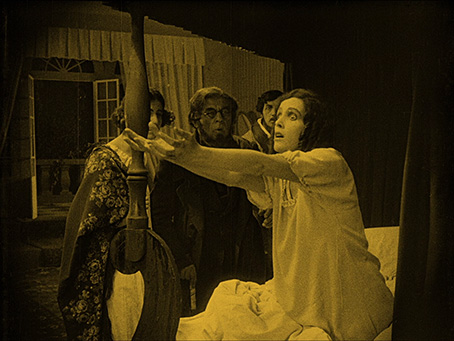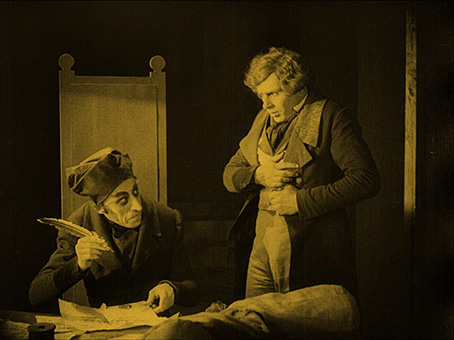|
I know that we're not talking big numbers here, but F.W. Murnau's seminal vampire movie Nosferatu is technically the most reviewed film on this site. Let me clarify that statement. We've only reviewed the film itself once (though in enough detail, I would hope, to not warrant a rerun), but have covered three of its DVD incarnations: the 2-disc 2001 Eureka release, the 2002 BFI version, and the 2-disc 2007 restoration, also from Eureka and released as part of the Masters of Cinema series. Now the film has made the transition to Blu-ray following a number of successful UK cinema screenings, some of them part of the BFI's Gothic: The Dark Heart of Film project, which rather neatly links the film's two previous UK home video distributors.
Having already written a lengthy review of the film – one I still regard as the godfather of the vampire genre and quite possibly the greatest of all vampire films – and supplemented that in my introduction to the 2007 restoration, I find myself with little to add to those pieces without running the risk of repeating myself. Thus, if you are looking for a lead-in to this edition, you can check out those reviews here:
Review of the film, the 2-disc 2001 Eureka DVD and the 2002 BFI DVD
Review of the Masters of Cinema 2-disc 2007 restoration DVD
On the new HD transfer, however, I have quite a bit to say, and so to business...
Reading some of the publicity and a few of the tweets surrounding the cinema screenings of this new HD edition, you could be forgiven for thinking that this is a new restoration, one that built upon the remarkable work carried out by Friedrich-Wilhelm-Murnau-Stiftung and showcased in the 2007 DVD release. As it happens, the 2007 restoration was also the basis for the 1080p transfer here, but if you think that means this Blu-ray will offer only a small advantage over the previous DVD then you're in for a serious and pleasurable surprise.
Some technical detail for newcomers. Nosferatu was restored (and I'm quoting from the booklet) by Luciano Berriatúa on behalf of Friedrich-Wilhelm-Murnau-Stiftung, Wiesbaden in 2005 / 2006. A tinted nitrate print with French intertitles from 1922 of Cinémathèque Française, Paris was used as basis for the restoration. Missing shots were completed by a safety print from 1939 of Bundesarchiv-Filmarchiv, Berlin / Koblenz, drawn from a Czech export print of the 1920s. Other shots were taken from a nitrate print of the 1930s' version, distributed under the title Die zwölfte Stunde [The Twelfth Hour] preserved at Cinémathèque Française, Paris.
Those who are familiar with the 2007 DVD (or have read our review of it) will be aware of the delight with which that restoration was greeted, a reaction I do feel the need to place in context. If you come to the restoration – particularly on Blu-ray (I'll get to that in a minute) – with no knowledge of the film's past misfortunes then you may well be a little blasé about the results. The exposure still flickers, there are still plenty of scratches and occasionally more pronounced damage, and the image is still intermittently subject to a little jitter. But it's important to remember that for a long time Nosferatu was close to being classified a lost film. Negatives were destroyed and the few surviving prints suffered all manner of ill treatment over the years. The image on the first VHS and DVD copies I owned was always in grim condition, plastered with dust and scratches, jumping furiously around in the gate and flickering with the frequency of a strobe light at a rave. We put up with this because we knew the film's history and were fully aware that this was the only way we were going to see it. When I first saw the Murnau-Stitung restoration I couldn't believe my eyes. Yes, there were still plenty of visual flaws, but given the film's previous condition, this new transfer was an astonishing achievement.
I know it's singing an old song now, but the arrival of Blu-ray really was a game-changer when it came to how we rate picture quality, and what we once championed as standard-setting often now falls short of where the bar now sits. Thus while the transfer on the 2007 Masters of Cinema DVD bowled us over at the time, the standard set by other MoC Blu-ray releases of classic silent cinema made it clear that there was room for improvement here. And boy does this transfer deliver. I was expecting there to be more visible detail, but not as much as this. Yes, there is some variance in the sharpness (hardly surprising given the multiple sources used for the restoration), but on the best material the level of detail is genuinely eye-popping. As a prime example, I offer our first view through Knock's window of that scarily slanted building that Knock plans to sell to Orlock – on the DVD we can see that it's a brick-built structure, but on the Blu-ray transfer there you can clearly make out almost every brick.

Compare the DVD grab (above) with the Blu-ray grab (below).
Click on the individual pictures for a full sized image.

It's a similar story just about anywhere you care to look, with detail that was indistinct on the DVD brought crisply into focus: the wallpaper behind Ellen when Thomas returns home from his place of work; the fur of the hyena that Thomas spies from the inn window; Orlock's eyebrow hairs and the texture of the cloth on his cap as he looks up from the agreement delivered to him by Thomas; the background detail on the shot so adored by Christopher Frayling as the death ship slides ominously into port. The contrast range is also noticeably more generous in its tonal range, giving the picture an even richer feel and bringing out previous unseen detail in darker areas. Comparing the screen grabs above, there also appears to be more picture information at the top and sides, and dare I suggest that the tinting is just a tad more subtle here? What really surprised me is the effect these enhancements had on my engagement with the characters and story, nullifying the sometimes distancing effect of age-battered imagery and giving the image a more contemporary feel.
As ever with quality HD restorations of films in less than perfect condition, scratches and other remaining flaws that were rendered almost invisible by the lower resolution of DVD are brought into sharp focus here. This can mislead the unprepared into thinking that there is more damage on this transfer than on the previous SD one, which is simply not the case. Live with it, as the benefits far outweigh these minor distractions. Watching the film ten years ago in its previously battered state, who'd have thought we'd ever see it looking this good?





The score is the same one included on the restoration DVD, being the music that accompanied the original screenings in Germany in 1922. Composed by Hans Erdmann and only ever performed live prior to the 2007 release, the score was recorded by the Radio Symphony Orchestra Saarbrücken and conducted by Berndt Heller. And it's no historical curio but a full blooded symphonic piece that compliments the film's Gothic beauty well and matches the mood set by the visuals at every step, though does occasionally plump for a sense of adventure on scenes that cry out for dread. You can choose between Linear PCM 2.0 stereo or DTS-HD Master Audio 5.1 surround – both are excellent quality, but the DTS surround track is considerably richer and more inclusive, surrounding you with music of exceptional clarity and range. Just lovely.
David Kalat Commentary
If I was drawing up a list of people I'd love to hear do a commentary for Nosferatu, then I'd have to put scholar and enthusiast for the film Christopher Frayling at the top, but running a close second would be film historian David Kalat. Already a veteran of Masters of Cinema releases of older German classics from Fritz Lang and Murnau, he has a rare and welcome talent for balancing detailed knowledge with infectious enthusiasm and even occasional levity, and that's very much the style adopts again here. This is not screen specific in the usual sense, with comments on individual scenes sharing space with detailed breakdowns of key information on the film's production and release. Kalat provides useful biographical information on Murnau, on producer and designer Albin Grau, on influential director and actor Max Reinhardt and several of the actors. He also explores in some detail a number of key background elements, including the vampire myth (which he cheerfully debunks with scientific explanations and the proclamation that a supposedly true tale used as part of the film's promotion was largely "bullshit"), the flu pandemic that helped to shape the contagion story strand, Murnau's use of montage, the parallels between aspects of the narrative and the life of Dracula author Bram Stoker, and a whole lot more. He identifies specific paintings that influenced the visuals and provides just about the most detailed breakdown I've yet encountered of the legal case that led to almost all prints of the film being destroyed. He ends on a typically enthusiastic note by assuring us that "Nosferatu survived because it is good. Uncommonly, profoundly, undeniably good. And oh boy have I enjoyed watching it with you." Excellent.
Brad Stevens and R. Dixon Smith Commentary
Ported over from the 2007 DVD release, this is a useful gathering together of information on the film and the various readings of its underlying meanings, one that should prove particularly useful to newcomers to the film and the numerous writings on it. Indeed, a fair amount of the points discussed here you'll also find covered in our own review of the film – I'd like to claim that this was somehow an influence on the commentary, but the points made are almost all either widely known or self-evident to those who have studied the film in any depth. One remark here that I will respond to, but can't take personal credit for, is the commentators' bemusement at the presence of what appear to be the crosses of graves on the shoreline, something a good friend of mine rationalised as being markers for local men who had died at sea.
The Language of Shadows: Friedrich Wilhelm Murnau and His Films (52:38)
A documentary specially made for F.W. Murnau-Stiftung by Luciano Berriattúa, one that gives the impression of being the first of a series on the director – this one focusses on Murnau's youth and early films before concentrating exclusively on Nosferatu. The childhood information and interviews with relatives of Murnau and his associates initially suggests a standard biographical piece, but this soon gives way to some revealing detail on the director's early 'lost' films, which are accompanied by stills and clippings and a rare surviving clip of his second film Satanas, whose blatant eroticism is, to say the least, intriguing. But the hook really bites once we get onto Nosferatu, particularly the tour of locations used for the film, many of which have changed surprisingly little in the intervening years. Those who have the 2001 Eureka disc may remember the extra feature there titled Nosferatu Recaptured, which took us on a similar trip around the locations, but they are covered here in considerably more detail and on video rather than as a series of stills.
Abel Ferrara (12:19)
An interview with maverick filmmaker Abel Ferrara, whose own 1995 vampire movie The Addiction is a personal favourite and who used clips from Nosferatu in The King of New York. The piece was originally filmed for the 2007 Masters of Cinema DVD release by Ferrara and Michael M. Bilandic on mini-DV, but was not included due to logistical and technical issues. That Ferrara rambles a little will surprise no-one who's listened to his audio commentary for King of New York, but he still delivers the goods, suggesting that vampire lore was incomprehensible to him until he received Nicholas St. John's script for The Addiction, and running through a range of vampire characteristics from different cultural myths. There's a warning up front about the resulting problems with both picture and sound, but frankly this is in better shape than a good many interviews I've seen included as DVD extras elsewhere, and despite being shot with the on-camera mic, Ferrara's growled delivery is always clearly audible.
Kevin Jackson (19:53)
The author of the BFI Classics book on Nosferatu discusses (at some speed) the importance of the role played by producer Albin Grau, the influence of his interest in the occult, Murnau's early career, the significance of the film's use of animals, the editing, the initial critical reaction, and more. All interesting stuff, particularly as it doesn't seriously duplicate material from elsewhere on the disc.
Booklet
The typically excellent booklet is, as usual with Masters of Cinema Blu-ray upgrades of films previously released by them on DVD, effectively a rerun of the one that accompanied the 2007 release, although is curiously missing the essay No End to Nosferatu by Thomas Elsaesser (do I detect a rights issue?). Not to worry. Still on board is the phenomenally detailed – though sometimes over-analytical – extract from The Material Ghosts: Films and Their Medium by Gilberto Perez (seriously, it's 28 tightly packed pages), a 1921 piece on vampires by Nosferatu producer and designer Albin Grau, notes on the 2007 restoration, sizeable extracts from an article by Enno Patalas detailing an earlier restoration, a short essay titled The Bridge by Craig Keller, film credits, stills, a press poster and the usual notes on correct viewing.
Back in 2007 (almost to the day – have Eureka timed this release deliberately?) I was singing the praises of the Masters of Cinema 2-disc DVD as the best ever home video release of Murnau's vampire masterpiece. Six years and a new home video format later and we have a new champion, also from Masters of Cinema. Within the restrictions imposed by the condition of the source material, the film looks fabulous, and the special features are even better than the previous release. Highly recommended – honestly, even if you have the earlier Masters of Cinema 2-disc DVD, you need to get your hands on this.
|